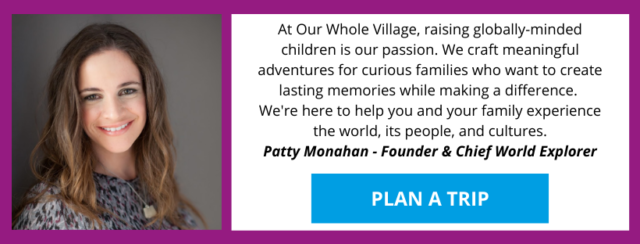The Best Family Vacation Spots in Iceland
ABOUT
At Our Whole Village, we plan meaningful vacations for families who want to create lifelong memories and show their kids the world in a more conscious and intentional manner.
WORK WITH US
We help families take meaningful vacations so that they can escape everyday life, show their kids the world and make lifelong memories - with care, confidence and peace of mind.
THE BEST FAMILY VACATIONS BY AGE
Your (free) guide to the top travel destinations for families with babies, teens and everyone in between.
DOWNLOAD NOW
ABOUT US
April 18, 2023
Myths abound about how Iceland got its name. Some say it came from the island’s first Norwegian settlers, including Hrafna-Flóki Vilgerðarson, who discovered it in A.D. 865. The “Hrafna” in his name meant “raven,” referring to the three domesticated rooks that guided them to the land. As for the “ice” in Iceland, it was the first thing that came to the settlers’ minds.
But others argue the moniker came from Irish monks, namely St. Brendan, who dubbed it Íssu (literally Jesus) in response to its pristine beauty. That said, sources also point to the fact Iceland may simply mean “island.” Whatever the case, the land of fire and ice’s official title doesn’t really do it justice. But that shouldn’t keep you and your family from making a date with this unique family travel hotspot.
If you’re looking for the perfect balance between outdoor adventure and sustainable travel, keep reading for the best family vacation spots in Iceland.
Who Should Visit Iceland
What to do in Iceland? From hiking glaciers to snorkeling continental fissures to scoping out the aurora borealis, it’s hard to beat a vacation to Iceland. Be sure to plan ahead and hire a flytographer for your stay in Reykjavik so that you have fun, fabulous, professional images to commemorate your trip.
Families will find a kid-friendly atmosphere filled with endless ways to pursue adventure. But the nature of such a trip makes it more suitable for families with older kids. Younger children will find it challenging to keep up, and some of the activities your family may wish to participate in have minimum age requirements.
That said, it’s a fantastic destination to look forward to when kids get older. So, you don’t have to cross it off your family travel list indefinitely.
Snorkel the Silfra Fissure
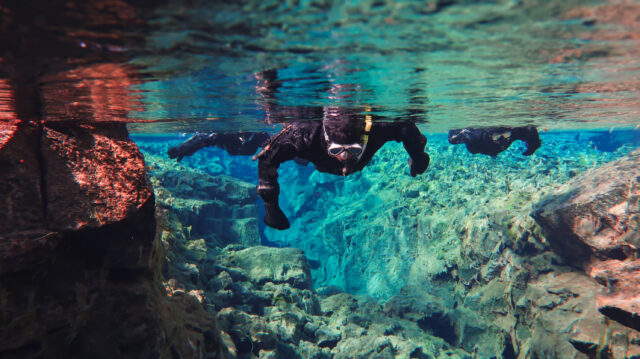
© VicPhotoria | Dreamstime
The waters of Silfra Fissure prove so crystal-clear snorkelers can see up to 330 feet down. The fissure exists in a gap between the tectonic plates of North America and Eurasia, the only place in the world where your family can swim between two continents! Located in Thingvellir National Park, Silfra represents a genuinely bucket-list-worthy experience.
That said, it won’t be the most comfortable thing you ever do. The waters of Silfra measure between 35 to 39 degrees Fahrenheit, and while wet suits help, your family will still want to warm up afterward. (No worries. We’ve got you covered in the next section.) But visitors agree that getting a little chilly is well worth the mesmerizing experience of being carried along by Silfra’s gentle currents while glimpsing into the depths of the underwater world.
Savor the Warming Waters of the Blue Lagoon
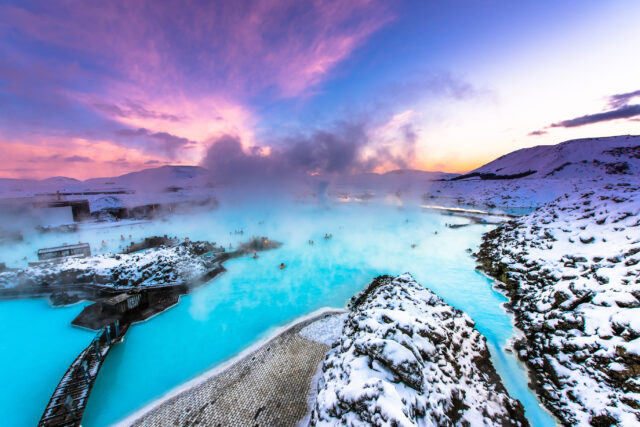
© Surangaw | Dreamstime
Remember our earlier promise about warming up after snorkeling Silfra? A visit to the Blue Lagoon is your answer. Since 1981, tourists to Iceland have flocked to the Reykjanes Peninsula to savor its bathtub-warm waters. Forty-five minutes from Reykjavik and 15 minutes from Keflavík International Airport, the Blue Lagoon is also highly accessible. Characterized by impossibly azure waters against a background of moss-covered black lava fields, there’s no better spot to warm up while feeling pampered.
The Blue Lagoon is fueled by the consistently warm runoff from Svartsengi geothermal plant. Waters typically remain between 98 and 104 degrees Fahrenheit. The shallow pools contain a mineral-rich layer of mud at the bottom, renowned for its therapeutic properties and ability to leave skin healthy, youthful, and radiant. For this reason, many people slather it generously on their faces. Besides the milky blue pools, you’ll find steam rooms, a spa experience, restaurants, and shops.
Eat Geothermal!
An impressive 85 percent of all homes in Iceland are heated using geothermal energy. But keeping residents cozy isn’t the only way geothermal energy gets harnessed on the island. Local farmers use this resource to heat greenhouses, where they cultivate an astonishing variety of plants, including lettuce, herbs, cauliflower, tomatoes, and mushrooms. Moreover, some local restaurants use the Earth’s heat to slow-cook their mouthwatering dishes.
These efforts have helped shrink Iceland’s global carbon footprint. But they’ve also contributed to the nutrition and integrity of the local food supply. Locations where you can eat geothermal cuisine include Friðheimar, which provides 40 percent of the island’s tomato supply. The destination hosts (you guessed it) a tomato-themed restaurant inside one of its largest greenhouses. And at Geysir Glima restaurant, enjoy a geothermal bread and egg cooking demo before diving into a menu featuring some of Iceland’s freshest fish and seasonal meat.
Discover the Center of the World in Snæfells
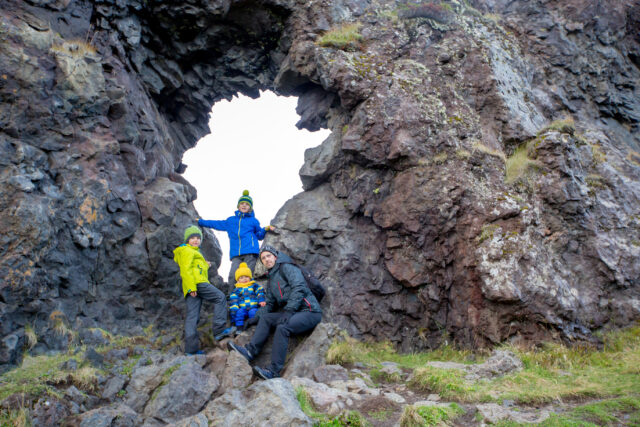
© Tatyana Tomsickova | Dreamstime
Outside of Iceland, few people know that Snæfells Peninsula contains the so-called “Center of the Earth.” Well, at least, according to Jules Verne. In his sci-fi work A Journey to the Center of the Earth (1864), Verne reveals the gateway to the Earth’s core on the summit of Snæfellsjökull. A nearly 4,000-foot-tall stratovolcano, the peak is located in Snæfellsjökull National Park.
A trip to the top of Snæfellsjökull requires a good local guide and cooperative weather. But it’s well worth the trip. On a hike, you’ll spy impressive craters, spectacular lava formations, and expansive panoramas of the island. Besides this famed literary location, the Snæfells Peninsula also houses the charming village of Stykkishólmur. A town of little more than 1,000 residents, it’s constructed on the foundations of a 16th-century trading post.
Explore the Reykjanes Peninsula
The Reykjanes Peninsula sits in the southwestern corner of the nation and contains various attractions, including hot mud pools, lava fields, and lighthouses. As an oft-overlooked region for tourists, you won’t have to vie with crowds while exploring it. Where to start your family’s exploration of Reykjanes Peninsula? Leif the Lucky’s Bridge.
What’s so great about this spot? It permits visitors to cross from the North American to European continents. Next, at Hvalsneskirkja, discover an immaculately preserved 19th-century church fashioned from driftwood and black stone. At Garður and Stafnes, Iceland’s rugged coastline gives way to picturesque lighthouses. The Reykjanes Peninsula also contains lava tunnels you can explore, as well as hot mud springs at Gunnuhver. And you won’t want to miss out on Kleifarvatn, the largest lake in the region.
Check Out the Golden Circle
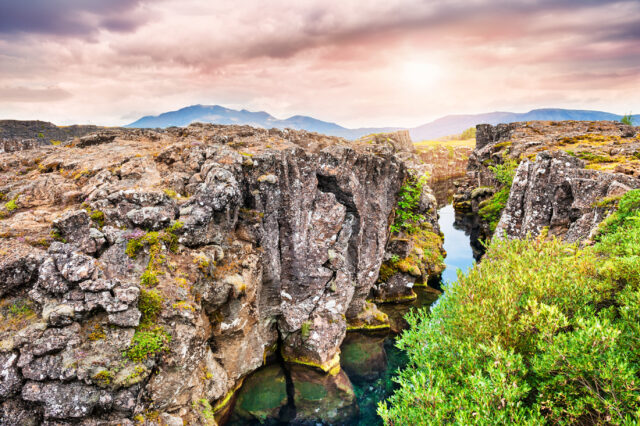
© Smallredgirl | Dreamstime
Besides snorkeling the Silfra Fissure, there’s much to see in Thingvellir National Park. Fortunately, it’s the first stop on a tour of the Golden Circle, renowned for its sweeping coastal views, stunning landscapes, and stark geology. When you enter the park from the Reykjavik side, you’ll drive past a sheer cliff marking the end of the North American continent and the beginning of the Eurasian continent jutting up dramatically a few miles away.
In Thingvellir, see the globe’s only glimpse of the Mid-Atlantic Ridge above sea level. In the Haukadalur Valley, keep your eyes open for evidence of geothermal activity, from volcanic vents to chimneys, hot pools to fumaroles and clay pots. You’ll also find two of Iceland’s most famous geysers: the Great Geyser and Strokkur.
Venture to Iceland’s Southern Coast

© 120129 | Pixabay via Canva
Iceland’s southern coast offers spectacular black sand beaches, expansive regions marked by volcanism, and towering waterfalls. Its jagged cliffs welcome thousands of local birds who make their nests in ocean-facing nooks and crannies. One of the best ways to birdwatch is on a guided boat tour of Jökulsárlón Glacier Lagoon, navigating between icebergs in pursuit of amazing shoreline views.
Diamond Beach is another fantastic location, its sandy shoreline interspersed with ice chunks that sparkle like diamonds in the sun. Head to two of Iceland’s most famous waterfalls for breathtaking views: Seljalandsfoss and Skógafoss. Take spectacular photos of the emerald-hued Eyjafjöll mountain range and the iconic volcano known as Eyjafjallajökull. And for incredible black sand beaches and whimsical geological formations, head to Reynisfjara.
Best Family Vacation Spots in Iceland
Iceland is a dream destination for families who wish to combine endless adventure with the principles of sustainable travel. From the crystal-clear waters of the Silfra Fissure to the black sand beaches of Reynisfjara, we’ll make building an exciting itinerary filled with the best family vacation spots in Iceland a cinch. What’s more, other fantastic family travel destinations include Denmark with kids and Norway with kids.
Looking for meaningful and immersive travel experiences? Work with our travel advisors. We know the ins and outs of voyaging with kids, and we have the priceless local connections to craft a one-of-a-kind getaway that’s culturally rich, ecologically conscious, and filled with luxurious perks. Whether you want to visit Iceland, Tanzania, Thailand, or somewhere in between, we’ve got you covered.
Let’s chat about your next family vacation.
OUR SERVICES
HOME
COPYRIGHT © OUR WHOLE VILLAGE 2021
DESIGN BY GIRLBOSS DESIGNER | CUSTOMIZED BY ALEX COLLIER DESIGN
about
TRAVEL SERVICES
DESTINATIONS
BLOG
PLAN A TRIP
FREE TRAVEL GUIDE
TERMS AND CONDITIONS
hello@ourwholevillage.com
+1 305 432 2612
